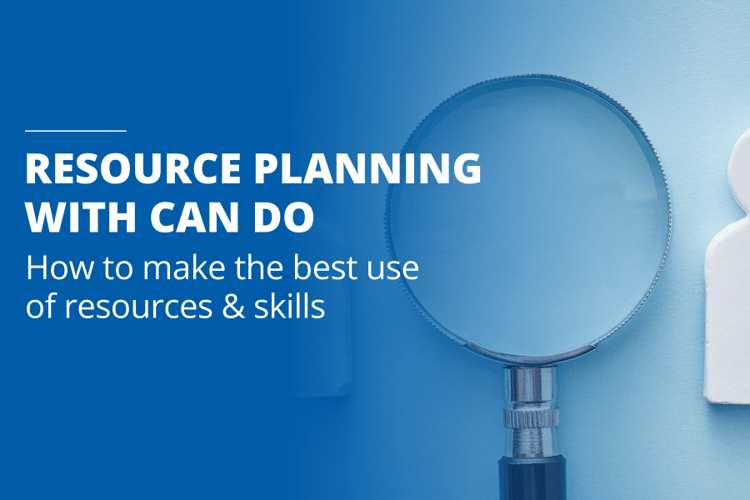"Who does what - and when? That is ultimately what project management is all about!" This quote from Can Do founder Thomas Schlereth sums up the importance of resource planning. In this article, we want to explain why our resource planning software places so much importance on resource management. And what Can Do does differently than other resource planning tools.

Can Do, the resource planning software
The resource planning tool Can Do is a PM software that offers benefits to all stakeholders. The individual teams, for example, benefit from Hybrid Project Management and can accomplish their work with the usual agile tools, while controlling their projects with the classic methodology (e.g. waterfall model). Management, in turn, has access to customized dashboards and receives up-to-date project information in the document format of their choice. And the PMO can be supported by an AI in the risk assessment of individual projects - or entire portfolios.
However, the linchpin of Can Do's resource planning software is resource management, which at Can Do is primarily Skill Management: Can Do ensures that all employees are assigned to those projects in which they can best contribute their individual skills. In addition, our resource planning software prevents disruptive absenteeism and idle time and allocates resources throughout the company. Can Do, the resource planning tool, can also be used for future skills development (personnel development). We will show you some functions of the PM software that support you in resource management or resource planning.
Absences / vacation planning
Staff absences mainly relate to vacations. But parental leave and longer illnesses must also be taken into account in long-term capacity planning.
As with any planning, predictability is a problem: It is known how many vacation days in total must be included in the planning for a person in a year - but not when the vacations will take place exactly. Therefore, we have developed a special part in the resource planning software where the annual leave number can be stored.
However, artificial intelligence does not simply distribute this vacation over the year on average. It would be nonsensical to do so because no one takes an hour of vacation per day. Instead, for a person who is scheduled 100% for a week by a project, for example, the AI recognizes that there will be no vacation during that period. The "vacation portion" for that week is then distributed among the other days. This realistic simulation is later replaced with actual requested and taken vacation. Thus, the total annual vacation number melts down over the course of the year due to actual vacations. This approach by Can Do's AI allows for much more realistic resource planning than rigid, statistical absence distribution.
Base load
People in companies do not work with 100% of their available working time exclusively in planned work of projects. Instead, they lose some time every day by talking to colleagues, receiving calls, answering mails or requesting travel reimbursement. This is not unproductive time, but it must be taken into account if resource planning is to become realistic. Such efforts are called base loads. Base loads are not planned in detail, but are usually standardized by a percentage value per month.
Can Do's AI simulates the work behavior in a month. For example, if a person has a day of vacation, the system knows that the base loads will also not be applied on that day. However, this effort does not fall away, but is shifted to the days before and after the vacation. In this way, the resource planning tool ensures that the monthly average of the basic load, for example 10 days, is maintained.
Simmulating projects
In many companies, new projects are simply agreed upon and released by management or sales. There is no simulation of whether the projects are even possible in this quantity and at this time due to the available capacity or skills. The resource planning software Can Do enables an exact, AI-supported project simulation and a realistic view into the project future. This makes it possible to decide in advance of a project whether it can be brought to success in its intended form - and when is the best time to start the project.
Top-down resource planning
The concept of so-called top-down resource planning is of central importance in every company. This procedure is necessary because a project cannot be planned in complete detail: The level of detail of planning changes over time.
At the beginning there is only the project with its long duration. In the project a team, persons or skills are now roughly (i.e. approximately) planned. The effort initially comes from a rough and imprecise estimate. The advantage of this approach is that the resources are also reserved over the period and are included in the medium-term capacity planning.
The effort reserved for the long term at the project level can then be planned one level down, to the phases. In doing so, the effort of the project is reduced accordingly. Thus the effort of the project is planned step by step one level down.
In the last step, normal packages are now planned within the first phase. Here, too, the effort is deducted from the level above, the phase, and thus distributed downwards.
What is special here is that even a named resource that is a member of a team is recognized by the resource planning tool. The effort of the planned team above it is recognized accordingly. So with Can Do it is not necessary to plan the whole project in such detail right at the beginning. All necessary resources are already correctly reserved over the different levels.
When the project is now underway and the first phase is, for example, half completed, it is possible to start planning the second phase in a little more detail.
This technique is called rolling planning.
Thus, two planning techniques are combined here and supported by the resource planning software Can Do: Top-down planning and rolling planning.
Portfolio Manager
In the resource planning software Can Do, any number of projects can be grouped into a Portfolio. Can Do permanently analyzes possible risks in the projects with an artificial intelligence and algorithms. A detailed analysis with a specific recommendation for action can also be retrieved.
The display is in real time, which means: If something changes in a project, for example the risk, this will be displayed here in real time. This gives you a perfect control center across all projects. Can Do can handle unlimited portfolios, and a project can be in multiple portfolios at the same time.
The resource utilization of all projects in a portfolio can also be displayed, and the resource planning tool Can Do can distribute resources company-wide and across departments if needed.
Conclusion
In a single blog post, we can only present some of Can Do's strengths for your resource planning - and only hint at their functional depth. Nevertheless, it has become clear that Can Do as a resource planning software supports your project management or your PMO with efficient tools for resource management.
Tools that we would be happy to demonstrate to you without obligation in a product presentation, adapted to your use case and your business challenges. Simply book an appointment and let us show you what Can Do can do for your projects and your company's success!
Jetzt anmelden - Can Do Newsletter
Our blog provides well-founded and practical content on project management, resource management, and the use of AI in businesses. Our goal is to equip professionals and decision-makers with tools, strategies, and inspiration to manage their projects and resources more efficiently and successfully.
Why Do Projects Fail? 5 Common Reasons - And How to Avoid Them
Projects are often complex, and even with the best intentions and a competent team, success can elude us. But why do so...
Cost-Cutting - Increasing Efficiency Without Additional Resources
Cost-cutting is currently at the top of the agenda for many companies. In the face of economic uncertainty and rising...
.png?width=200&height=80&name=CanDo%20Logo%20transparent%20(500%20x%20200%20px).png)

